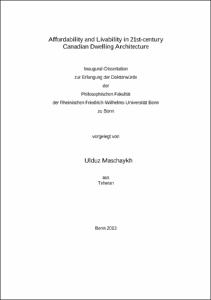Maschaykh, Ulduz: Affordability and Livability in 21st-century Canadian Dwelling Architecture. - Bonn, 2013. - Dissertation, Rheinische Friedrich-Wilhelms-Universität Bonn.
Online-Ausgabe in bonndoc: https://nbn-resolving.org/urn:nbn:de:hbz:5-32844
Online-Ausgabe in bonndoc: https://nbn-resolving.org/urn:nbn:de:hbz:5-32844
@phdthesis{handle:20.500.11811/5586,
urn: https://nbn-resolving.org/urn:nbn:de:hbz:5-32844,
author = {{Ulduz Maschaykh}},
title = {Affordability and Livability in 21st-century Canadian Dwelling Architecture},
school = {Rheinische Friedrich-Wilhelms-Universität Bonn},
year = 2013,
month = sep,
note = {This dissertation explores affordable housing options in Canada’s westernmost Province, British Columbia in the 21st century. The projects are carried out based on corporations between provincial housing programs, the architects’ and communities’ commitment as well as the private building sectors. The aim of this dissertation is to emphasise the role and impact of architecture on gentrification, from an art historical perspective.
The depicted case studies will be examined in context of the neighbourhood they are placed in, which are either in the process of urban transition or already gentrified. The premise is to elaborate more on the question: What role does architecture play in the process of gentrifying neighbourhoods and how does affordable housing fit in this scenario? Findings show that despite the lack of constitutional right to affordable and liveable housing in Canada there are significant architectural projects that help to meet the needs and desires of low to middle income tenants and home owners. Since origins of affordable housing can be traced back to Europe’s late 19th and early 20th century a brief overview will be given on the emergence of the idea of housing settlements, arts-and-crafts-movement, Red Vienna and housing politics under the Weimar Republic.},
url = {https://hdl.handle.net/20.500.11811/5586}
}
urn: https://nbn-resolving.org/urn:nbn:de:hbz:5-32844,
author = {{Ulduz Maschaykh}},
title = {Affordability and Livability in 21st-century Canadian Dwelling Architecture},
school = {Rheinische Friedrich-Wilhelms-Universität Bonn},
year = 2013,
month = sep,
note = {This dissertation explores affordable housing options in Canada’s westernmost Province, British Columbia in the 21st century. The projects are carried out based on corporations between provincial housing programs, the architects’ and communities’ commitment as well as the private building sectors. The aim of this dissertation is to emphasise the role and impact of architecture on gentrification, from an art historical perspective.
The depicted case studies will be examined in context of the neighbourhood they are placed in, which are either in the process of urban transition or already gentrified. The premise is to elaborate more on the question: What role does architecture play in the process of gentrifying neighbourhoods and how does affordable housing fit in this scenario? Findings show that despite the lack of constitutional right to affordable and liveable housing in Canada there are significant architectural projects that help to meet the needs and desires of low to middle income tenants and home owners. Since origins of affordable housing can be traced back to Europe’s late 19th and early 20th century a brief overview will be given on the emergence of the idea of housing settlements, arts-and-crafts-movement, Red Vienna and housing politics under the Weimar Republic.},
url = {https://hdl.handle.net/20.500.11811/5586}
}






